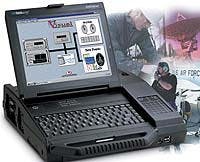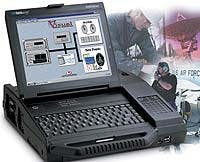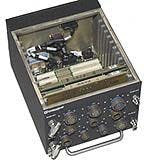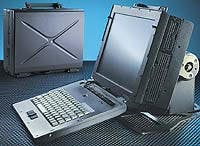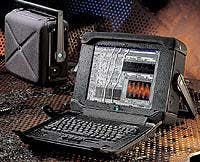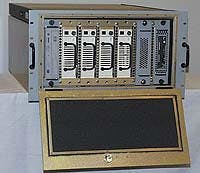Purely commercial off-the-shelf computers are extremely rare in military applications where operating environments can be extremely harsh, so electronics designers customize standard products to meet the exacting demands of their customers. Experience with military designs can be a key deciding factor.
By John Keller
Since 1994, words like standardized commercial off-the-shelf (COTS) have been repeated like mantras in U.S. military electronics procurements. It would seem now, seven years later, that strictly defined standard off-the-shelf hardware and software would be the norm, yet the reality is actually quite different. It is true, in the period since COTS became a Pentagon watchword, that standard off-the-shelf equipment has become the foundation of most new American military electronic systems and systems upgrades, but rarely is this equipment strictly COTS.
Enter human nature. Nobody wants to buy the same thing his competitor buys. Where is the advantage in that? For the same token, no supplier wants to offer what the shop next door sells. How would that attract customers? "There are endless issues of people's needs that you don't necessarily find off the shelf," explains David Bosco, general manager of the CRI division of RSI Inc., a provider of modified COTS computers headquartered in Austin, Texas.
So ultimately, what we see as the legacy of the COTS movement is a broad variety of modified COTS military equipment. New generations of "customized COTS" — a contradiction if there ever was one — is the rule of today's military procurement, especially when it comes to rugged computers for military applications. This trend undoubtedly will proliferate as the concept of COTS matures and comes to reflect the routine way of doing military electronics procurement.
"It all comes down to different levels of adaptation," says Colin Davies, product manager in the systems business unit of Radstone Technology, a rugged computer and printed circuit board supplier in Towcester, England. In military computer procurement, "it is degrees of customization," he says. "There is no such thing as [pure] commercial off the shelf, because there are always some modifications."
In all but the most benign applications, the environments in which military electronics must operate reliably are far more demanding than the typical desktop. Severe military operating environments certainly apply to temperature extremes, shock and vibration, sand and dust, humidity, and salt spray. But military environments also apply to special packaging to fit computer equipment into unconventional spaces — such as in the nose of an unmanned aerial vehicle. "It is rare to find two people who want the same thing," Davies says. "They want different board sets, serial ports, or connectors, and once you get into it, the same thing tends to be totally different in terms of what you put in the box."
The demand for, and the ability to perform, customized work on military computers varies from company to company. Typically the more customization the customer demands, the higher the price he pays. Systems integrators, therefore, should maintain keen focus on their needs for capability, reliability, and resistance to environmental extremes to balance performance and cost.
Levels of customizationSome companies, such as Argon Corp. in Great Neck, N.Y., make customizing computers their specialty. "It is rare that one of our computers can sell to two customers," says Moshe Albaum, sales engineer at Argon. "We don't try to maximize any investment in design, because design is part of the business; things have to be integrated and alterations have to be made. Most people here are engineers. We take engineering as a way of life. There is no such thing as you are done and now you do production. We do engineering all the time."Among Argon's flagship products is a standard ruggedized computer piggybacked with a rugged monitor in front, Albaum says. One application of Argon custom computers is aboard helicopters. "We make our basic design very modular; the monitor is shared between customers," Albaum says. "We change the computer boxes to meet individual demands. Some are thick, some are thin, and it depends on how many cards it needs." Argon leaders do not mention programs by name, but support several Navy shipboard, submarine, and helicopter programs, as well as tactical vehicle-mount work.
Full-custom computer design for rugged military applications is the forte of Macrolink Inc. of Anaheim, Calif., whose engineers have specially designed VME and CompactPCI-based rugged computers for several military aircraft applications, and most recently for the U.S. Naval Research Laboratory's Shared Reconnaissance Pod — better-known as SHARP. Customers approach Macrolink "for an environmental or requirements issue, as well as where packaging constraints are concerned," says George Hendershot, manager of the Macrolink ATR business unit.
Macrolink is especially skilled at designing computers for unconventionally shaped tight spaces aboard military and aerospace platforms, as well as for temperature extremes, Hendershot says. "If the customer wants to start the computer at -40 degrees Celsius, we put in internal heaters. You have to design that into the product from the start," he says.
Another company with heavy emphasis on custom work is CRI. Our work is as high as 50 percent custom," Bosco says. "Almost everything we do starts as a custom design and we then sell it as a custom product. Often it needs to have added capability or fit in this envelope or that envelope." CRI engineers developed a compact SGI Onyx II computer workstation to fit in the nose of a Predator unmanned aerial vehicle (UAV) — the same kind flying missions over Afghanistan. CRI's computer on the Predator involves removable disk drives a 28-volt power supply, mil-spec protection against electromagnetic interference, and environmental sealing. "The biggest issue in that one was fitting 10 pounds into a 5-pound bag," Bosco quips.
Modular approachThe foundations of CRI's designs, however, are commercially developed standard equipment, Bosco says. "We deal primarily with modified COTS — the customer who has decided on his specific system that he wants to custom package." Bosco points out, however, that little of his company's work involves full-custom designs. "We are not designing components from the ground up. There are not too many ruggedizers around who are building their own devices." Much of today's full-custom computer designs, he says, come from inside prime contractors that are working on large programs with extraordinary needs. "Some of the big primes may have a five-to-ten-year production program where they will build a custom design system for a specific application where COTS won't suffice."Miltope Corp. of Hope Hull, Ala., has a long history of custom military computer work. "Very little of what we offer is off the shelf; we chase a program rather than a requirement," says Jeff Palombo, vice president of programs at Miltope. "Generally that product then becomes a catalog item for us. Our catalog items begin as custom products." Miltope made a name for itself in the late 1980s by winning a large U.S. Army program for rugged battlefield computers called Common Hardware-Software I — better known as CHS-1.
Still, Miltope designers take a modular approach so they can offer their computers to as broad a customer base as possible. "We target more of the typical military environmental requirements," Palombo says. "By designing to more stringent requirements, our products are more usable across the different military applications. We have already met those military requirements in our design processes."
Modularity is also a core approach to designing custom military computers at Vista Controls Corp. in Santa Clarita, Calif. Vista engineers have experience designing custom and standard computers for military programs such as the U.S. Army M1 Abrams main battle tank, the Global Hawk UAV, and the F-16 jet fighter.
"What we bring to the party is taking some of our standard products for the development environment, such as the PowerPC 603 VME card, and spin that into a custom form factor," says Doug Patterson, Vista's director of marketing. "On a standard product we develop for an off-the-shelf box or chassis, we take input from multiple customers and work on speculation." Such an approach has its risks, but if speculation is correct it can have big payoffs, Patterson says.
Another of Vista's centers of expertise involves software, he says, which gives the company a leg up on systems-integration work. "The mandate from our customer base has been strong and clear — provide us more of an integrated systems approach," Patterson says. "That is very much where Vista comes from. We do application software as well, and we understand the problems the customer is trying to solve."
Middle groundOccupying a middle ground between standard and full-custom equipment is Dolch Computer Systems of Fremont, Calif., which provides ruggedized computers for several different military applications, including a custom-designed loadmaster computer for the U.S. Air Force C-17 airlifter jet. Dolch officials say they are skilled at striking the right balance between custom and COTS components — and also when to accept jobs and where to reject them. "Often when it comes down to it, you have to do a lot of engineering work from scratch; in just modifying equipment there are limitations," explains Myles Kelvin, executive director of marketing at Dolch. "It is difficult to decide which projects to take on," Kelvin says. "The trick is picking the right projects. You must be comfortable that you can meet the customer's requirements without spending an arm and a leg on esoteric engineering. It comes down to experience."Kelvin says Dolch engineers employ a modular approach to custom systems, which helps them use tested and reliable components that have worked reliably under similar conditions to those in which the system must operate. The modular approach also helps Dolch not only deal routinely with trusted component suppliers, but also gain economies of scale to do custom work efficiently. "In a modular approach, we tend to use consistent suppliers so we know their product will be okay," he says. "On a military contract, we can do the engineering cheaper than competitors can. The modular approach has its limitations, however, and Kelvin is first to admit that. "You cannot build a super modular computer that would be right for everyone. It would be too expensive for everyone."
Also straddling the line between full-custom and COTS is Rugged Portable Systems (RPS), a division of Secure Communications systems, in Santa Ana Calif. "Fifty percent of our business is customized, and the other 50 percent is customizable to be flexible," says Larry Aguilar, vice president of business development at RPS. "We can pretty much configure it for a specific application." The U.S. Air Force Missions Support System — better known as AFMSS — and the U.S. Marine Corps Topographical Production Center, or TPC, use rugged computers from RPC.
Requirements to which RPC engineers design computers "all depends on each customer," Aguilar says. "They may want to drop it in the mud, wash it off with a hose, and have it operate. They may want to meet MIL-STD 461 and not transmit and pick up signals from other devices, operate off universal power, generator power, or battery, all in one box, so we offer those kinds of things."
DY 4 Systems in Kanata, Ontario, has a history and a reputation as a designer of custom and standard printed circuit boards, but in recent years has branched into designing ruggedized subsystems that rely primarily on DY 4 boards. DY 4 recently inked a rugged-computer partnership deal with AP Labs of San Diego, where DY 4 will provide circuit boards, and AP Labs will provide chassis (see story page 1).
"We don't as a general rule get involved in custom box-level solutions, but we do get involved where the customer upgrades proprietary boxes with no open systems inside," says Duncan Young, DY 4's director of marketing. "We offer a standard product in reformatted form. Essentially our standard products are modular in design and we can take the design modules and mix and match some of them to fit into a new card size. Sometimes we take the VME bus off altogether and interface to his proprietary system. We create something from our standard building blocks to fit in the customer's proprietary box."
Modified COTSAmong the custom-designed computer companies that specialize primarily on modified standard products is Kontron Mobile Computing Inc., in Eden Prairie, Minn. (formerly FieldWorks). The flagship of the Kontron Mobile products is the FieldWorks 8000 rugged portable computer. "That product is vanilla ice cream; you always put something in it to make it something other than a laptop, such as 1553 [data bus], which is one of the common ones." says Lisa Baker, Kontron Mobile's vice president of marketing. "We are on the Global Hawk UAV ground flight line ground station, which is the mission uploader, and mission downloader."What makes the Global Hawk mission uploader and downloader custom "is just what goes in the back card cage; our card cage is standard off the shelf, and the systems integrators modify it to make it custom." Baker says. "Global Hawk, has specific onboard computers, and its interfaces are different from those of C-130 or Joint Strike Fighter aircraft. We have different kinds of LRUs on Global Hawk, and each company that uses us uses our product differently. They modify the box to work with C-130, JSF, and Global Hawk in different ways."
Kontron engineers also can change the position of the computer's handle or location of its power supply to accommodate separate users, Bakers says. "Some people think of a cosmetic change as no big deal, but it's not such a small deal with a rugged computer with cooling and electrical issues," she points out.
Military engineering experienceIt stands to reason that adapting commercially developed computers for military use requires a substantial amount of specialized engineering know-how and innovation. "All of us are really from the defense industry," says Argon's Albaum. "It was a logical step to draw talent from a place like that. For these people there is nothing new in the military environment."This bank of military-design talent often can be a godsend for major defense contractors, which over recent years have lost much of their internal custom-engineering talent. "Generally the sorts of problems we solve, our customers don't have the system engineering for those that they once did," says Radstone's Davies. In addition, custom-engineering expertise at Radstone and other companies can help fill gaps at relatively small companies that never had engineers with military-design expertise in the first place. "They don't ask the right question at the right time, and at the end of the day you can have a meaningless compromise," he says. "With COTS many don't have the engineering, and don't understand the game rules."
CRI also has on staff several engineers with military-design experience. "In our case we have a number of Lockheed-Martin electrical and mechanical engineers," Bosco says, who performed systems engineering and systems analysis at the former Lockheed Martin plant in Austin, Texas, which closed in the 1990s. "When we started this division I knew whom to get," Bosco says. "It fell into our laps. It is not easy for a small company to acquire the expertise for custom work. Most commercial engineers would not have this kind of expertise under their belts."
Without engineers on staff with military design experience, much of what Macrolink does today would be impossible, Hendershot says. "It's hard to take commercial people to do military; it just doesn't work," he says. "It takes so long to understand the military environment and the military design process." Hendershot says all his engineers have military experience gleaned from companies such as Boeing, Raytheon, and Hughes. "My group is solid military," he says.
Military experience on staff also is a staple at RPS. "We have some experienced people here who have come out of the aerospace industry with knowledge of mil specs and configuring different systems for different applications, such as integrating third-party cards," Aguilar says. "100 percent of our business is military."
Engineers at Vista can stand on their reputations as military systems designers. "Vista has applications expertise," Patterson says. "If a customer comes up to you and asks for supply mil-spec boards for a turret site stabilization program, we have that experience and expertise. Our engineers use that to work with the customer's engineers; we can work with the program as a partner, and we have engineers on staff that has that kind of experience."
Sky Computers offers seminar on how to repackage COTS computers for military applicationsLeaders of Sky Computers Inc. of Chelmsford, Mass., are offering a tutorial program to help military and aerospace electronics integrators repackage standard commercial off-the-shelf (COTS) technology for extreme operating environments.The tutorial is called the Mission Ready COTS program, which is to provide military systems integrators with a guide to selecting technologies and vendors across the COTS electronics landscape, Sky officials say.
"We are more and more in the business of repackaging our commercial technology for extreme environments," explains Dianne McDermott, director of marketing programs at Sky. "We had been offering more and more white papers on buying COTS for rugged and extreme applications. Mission-ready COTS came from small pieces of the decision process."
Sky Computers specializes in single-board computers and in high-speed computer interconnects, as well as in repackaging standard computers for extreme operation conditions. "There is a lot of expertise here, and we thought we should put it into a seminar," McDermott says. "We have a program that includes work and a workbook with all the decisions the designer needs to consider when deploying COTS for extreme environments."
The program is in its infancy, and should be ready for presentation by this month, McDermott says. Its first public presentation will be at the Commercialization of Military and Space Electronics in February in Los Angeles.
"The main body of the material is really vendor-independent. You could put any vendor's name on this book and it would still work," McDermott says. "We didn't want to appear that this was a selling exercise; it is expertise developed over time that some companies don't have the need or expertise to do. The program is free, and we will do it for anybody."
For more information contact McDermott at Sky Computers by phone at 978-250-1920, by fax at 978-250-0036, by post at 27 Industrial Ave., Chelmsford, Mass. 01824, or on the World Wide Web at http://www.skycomputers.com/news/missionready.html. — J.K.
Who's who in custom-designed rugged computersAP LabsSan Diego, Calif.Phone: 858-546-8626Fax: 858-546-0278http://www.aplabs.com/Argon Corp.Great Neck, N.Y.Phone: 516-487-5314Fax: 516-487-5121http://www.argoncorp.comAzonix Corp.Billerica, Mass.Phone: 978-670-6300Fax: 978-670-8855http://www.azonix.com/Broadax Systems Inc.City of Industry, Calif.Phone: 626-964-2600Fax: 626-964-2665http://www.bsicomputer.comComputer Ruggedization Integration (CRI)Austin, TexasPhone: 512-386-7500Fax: 512-386-7518http://www.rsi-cri.comCyberchron Corp.Cold Spring, N.Y.Phone: 845-265-3700Fax: 845-265-4154http://www.cyberchron.comCytec Corp.Dallas, TexasPhone: 214-349 8881Fax: 214-349-8994http://www.cytecsys.comDRS Technologies Electronic Systems GroupGaithersburg, Md.Phone: 301-921-8100http://www.drs.com/Dolch Computer SystemsFremont, Calif.Phone: 510 661-2220Fax: 510 490-2360http://www.dolch.comDY 4 Systems Inc.Kanata, OntarioPhone: 613-599-9191Fax: 613-599-7777http://www.dy4.com/Getac Inc.Lake Forest, Calif.Phone: 949-699-2888Fax: 949-699-1440http://www.getac.comGreco SystemsEl Cajon, Calif.Phone: 619-442-0205Fax: 619-447-8982http://www.grecosystems.com/Itronix Corp.Spokane, Wash.Phone: 509-624-6600http://www.itronix.comKontron Mobile Computing Inc.Eden Prairie, Minn.Phone: 888-343-5396http://www.field-works.comMacrolink Inc.
Anaheim, Calif.
Phone: 714-777-8800
Fax: 714-777-8807
http://www.macrolink.com/
MCH Systems Inc.
Thousand Oaks, Calif.
Phone: 805-374-9110
Fax:805-373-6038
http://www.mchsys.com/
Melard Technologies Inc
Armonk, N.Y.
Phone: 914-273-4488
Fax: 914-273-1775
http://www.melard.com
Miltope Corp.Hope
Hull, Ala.
Phone: 334-284-8665
Fax: 334-613-6302
http://www.miltope.com
Paravant Computer Systems Inc.
Palm Bay, Fla.
Phone: 321-727-3672
http://www.paravant.com
Phoenix Group Inc. (PGI)
Hauppauge, N.Y.
Phone: 631-951-2700
Fax:631-951-4290
http://www.ivpgi.com/
Radstone Technology PLC
Towcester, England
Phone: +44-1327-359-444
Fax: +44-1327-358-113
http://www.radstone.co.uk
Rugged Portable Systems
Santa Ana, Calif.
Phone:714-541-1174
Fax: 714-541-1373
http://www.rpseagle.com/
Stealth Computer Corp.
Woodbridge, Ontario
Phone: 905-264-9000
Fax: 905-264-7440
http://www.stealthcomputer.com/
Tadpole-RDI
Carlsbad, Calif.
Phone:760-929-0992
Fax: 760-931-1063
http://www.tadpole.com/index-trdi.html
Talla-Com Industries Inc.
Tallahassee, Fla.
Phone:850-580-0420
Fax: 850-580-2626
http://www.t-com.com/
Vista Controls Corp.
Santa Clarita, Calif.
Phone:661-257-4430
Fax: 661-257-4782
http://www.vistacontrols.com/
